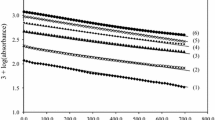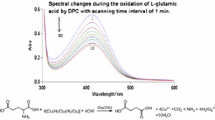Summary
The kinetics of the reaction of hexaaquachromium(III) ion with aspartic acid in aqueous-acidic medium have been investigated spectrophotometrically at [H+]=1×10−4 – 10× 10−4mol dm−3, t=35–45 °C and μ=1.0 mol dm−3 (KNO3). The results are in accord with a mechanism involving a fast 1∶1 outer-sphere association between hexaaquachromium(III) ion and the substrate species, followed by their transformation into the product by the process where the incoming ligand is appreciably bounded to the metal ion in the transition state. The rate law consistant with the mechanism is as follows:
The rate parameters were evaluated and associated activation parameters calculated using the Eyring equation. Enthalpy and entropy terms for the rate constants:viz. ΔH≠(k1)=+81±1 kJ mol−1, ΔH≠(k2)=+50±1 and ΔS≠(k1)=−54±3 JK−1 mol−1, ΔS≠(k2)=−157±2 JK−1 mol−1 are indicative of an (Ia) mechanism. Comparison of the results with published data on this metal ion also provide evidence of an associative interchange mechanism.
Similar content being viewed by others
References
T. W. Swaddle,Coord. Chem. Rev., 38, 217 (1974) and the refs. contained therein.
M. Kimura and J. Shirai,J. Inorg. Nucl. Chem., 40, 1085 (1978).
S. C. Tyagi and A. A. Khan,Indian J. Chem., 19A, 657 (1978).
S. C. Tyagi and A. A. Khan,J. Inorg. Nucl. Chem., 40, 1899 (1978).
I. A. Khan and Kabir-ud-Din,J. Inorg. Nucl. Chem., 43, 1082 (1981).
I. A. Khan, M. Shahid and Kabir-ud-Din,Indian J. Chem., 22A, 382 (1983).
I. A. Khan and Kabir-ud-Din,Indian J. Chem., 23A, 98 (1984).
I. A. Khan and Kabir-ud-Din,Int. J. Chem. Kin., 17, 1263 (1985).
W. Mertz,Science, 213, 1332 (1981); W. Mertz, E. W. Toepfer, E. E. Roginsky and M. M. Polansky,Fed. Proc., 33, 2275 (1974); W. Mertz,Physiol. Rev., 49, 163 (1969).
E.W. Toepfer, W. Mertz, M. M. Polansky, E. E. Roginsky and W. R. Wolf,J. Agric. Food Chem., 25, 162 (1977).
T. Ramasami, R. S. Taylor and A. G. Sykes,Inorg. Chem., 15, 2318 (1976).
D. Banerjea and S. Duttachaudhuri,J. Inorg. Nucl. Chem., 30, 871 (1968).
B. K. Niogy and G. S. De,J. Indian Chem. Soc., 61, 389 (1984).
B. K. Niogy and G. S. De,Proc. Indian Acad. Sci, (Chem. Sci.), 92A, 153 (1983).
A. A. Khan and W. U. Malik,Curr. Sci. (India), 29, 135 (1960).
Lassocinska,Rocz. Chem., 47, 889 (1973).
R. H. Mahler and H. C. Eugen,Biological Chemistry, 2nd. Edit., Harper and Row Publishers, New York, 1971.
R. E. Hamm and R. E. Davis,J. Am. Chem. Soc., 75, 2083 (1953).
R. E. Hamm and R. H. Perkins,J. Am. Chem. Soc., 77, 2083 (1955).
R. E. Hamm, R. L. Johnson, R. H. Perkins and R. E. Davis,J. Am. Chem. Soc., 80, 4469 (1958).
D. Banerjea and S. Dutta Chaudhuri,J. Inorg. Nucl. Chem., 32, 1617 (1970).
J. H. Espenson,Inorg. Chem., 8, 1554 (1969).
D. Thusius,Inorg. Chem., 10, 1106 (1971).
R. D. Shannon and C. R. Prewit,Acta Crystallogr. Sec. B, 25, 925 (1969).
R. G. Wilkins,The Study of Kinetics and Mechanism of Reactions of Transition Metal Complexes, Allyn and Bacon Boston, 1974, pp. 194.
Author information
Authors and Affiliations
Rights and permissions
About this article
Cite this article
Khan, I.A., Kabir-ud-Din Kinetics of anation of hexaaquachromium(III) Ion by aspartic acid: mechanism and activation parameters. Transition Met Chem 11, 391–395 (1986). https://doi.org/10.1007/BF01225990
Received:
Issue Date:
DOI: https://doi.org/10.1007/BF01225990




